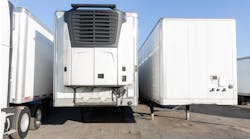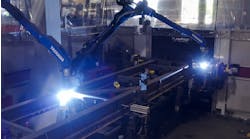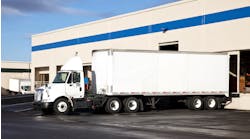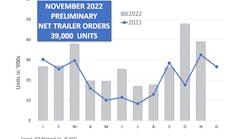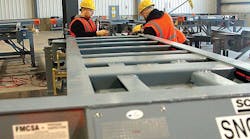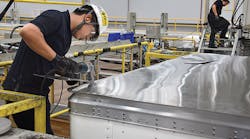Top-25 Trailer Builders Reach Previous Record of 340,000 Trailers and Chassis
The 25 largest trailer manufacturers in North America built some 340,000 truck-trailers and container chassis in 2015, a 16.6 percent increase over the preceding year.
The previous record for the Top-25-plus trailer builders’ output was set in 1999 when the 25 largest manufacturers built 339,664 truck-trailers and container chassis. The new number in 2015 for these 25-plus builders is 339,948 trailers and chassis. That is a gain of 284 trailers. That 0.08% difference may be too close to call it a new record. At least, it certainly is a tie with the 1999 number.
The six largest manufacturers built 272,000 trailers and chassis, or 80% of the total 340,000 units built by this Top-25 trailer group. All six of these largest builders are van trailer builders, and they also produce other types of trailers.
The biggest challenge in 2015 was the precipitous drop in petroleum prices, which affected most the builders of tank trailers, as well as pneumatic dry bulk trailers, lowboys and heavy haulers. However, platform and dump trailer specialists found improving markets in construction and housing.
The biggest change this year was the high number of container chassis. Four trailer manufacturers reported assembling 39,780 container chassis in 2015, an increase of 54% over the preceding year. Back in 1999, the previous record year, the Top-25 trailer manufacturers assembled almost as many chassis—37,800—or 11.1% of the trailer and chassis total. In 2015, container chassis represent 11.7% of the trailer/chassis total.
Only six manufacturers in this Top-25 group reported building fewer trailers in 2015, but this does not mean these were financial losses. It may mean producing fewer but higher value trailer configurations.
The trailer totals reported here cannot be compared directly with other domestic surveys that do not also include Canadian and Mexican assembly plants. This survey does not attempt to report on the many small manufacturing plants located throughout North America, so the total trailer build is a somewhat higher number than numbers shown here.
Find the latest report by choosing "Trailer Output" in the menu at top left.
This Trailer/Body Builders survey is made by telephoning a member of the management team at each manufacturing company. The ranking of the companies does not necessarily reflect their relative success in terms of profitability or revenue received, but only the number of trailers manufactured. The dollar value of a trailer can vary greatly depending on design, type of construction, materials used, and quality level.
Here is how the individual trailer manufacturers performed in 2015:
► Wabash National Corporation had record net sales for the fourth consecutive year—reaching over two billion dollars. Its operating income of $180.4 million was also a record, making a record operating income margin of 8.9%
Wabash built 62,950 truck-trailers in 2015, a 12% increase over the previous year. Dry freight vans were 50,550, an 11% increase. Refrigerated trailers numbered 4,550, a 38% increase, and platforms increased 16% to 4,450 flatbeds. Only tank trailers were down at 3,400 tanks, a 4% decline. Not counted in these trailer numbers are 1,750 converter dollies, up 46%, and 450 non-trailer truck bodies, up 13%.
“We enter 2016 with great momentum and a strong trailer demand environment generating a strong backlog,” said Dick Giromini, president and chief executive officer. “Our healthy backlog of orders totaling $1.2 billion represents a 10% increase over the previous year. Trailer demand is expected to be above replacement levels for a fifth consecutive year.
“Fleet age, customer profitability, used trailer values, regulatory compliance, and access to financing all support continued strong trailer demand and provide a favorable pricing environment within specific product lines,” Giromini said.
Wabash expects to build 60,000 to 62,000 trailers in 2016. Giromini said. The company also announced it is making a major commitment to produce van bodies—dry freight vans and refrigerated bodies. According to Wabash, the market for Class 5-7 van bodies is about 40,000 units per year. The company believes it will achieve about a 20% share of that market over the next four or five years.
The company’s diversification program over the past years has resulted in its broad offerings under its many brand names: Wabash National, Beall, Benson, Brenner Tank, Bulk Tank International, DuraPlate, Garsite, Progress Tank, Transcraft, Walker Engineered Products, and Walker Transport.
► Great Dane Limited Partnership produced 51,500 truck-trailers in 2015, which is an eight percent increase over the previous year. The company also built 1,000 truck bodies, which are not counted in the trailer total.
► Hyundai Translead built 49,713 truck-trailers in 2015, a 30% increase over the previous year, which was a 38% increase over 2013. Dry freight vans totaled 40,418, a 29% increase. Refrigerated trailers were 2,083, down 17% from 2014.
Container chassis production in 2015 at Hyundai Translead numbered 7,021 a 60% increase, and flatbed production was 191, a 38% increase. The company also built 496 converter dollies, which are not counted in the trailer total.
Trailer production was steady throughout the year, including a strong end of December, and it is continuing at the same pace in January. With new trailer orders being scheduled into October, the company is cautiously optimistic that 2016 will be another good year on a par with last year, says Brett Bartels, deputy general manager, sales and marketing strategy.
Hyundai has 93 dealer locations in the United States, Canada, and Mexico, after adding eight new locations during 2015. Production facilities are located in three large plants located near the border in Tijuana, Mexico. Corporate headquarters are across the border in San Diego, California.
► Utility Trailer Manufacturing Company celebrated its fifth record year in a row. It built 49,187 trailers in 2015, which is 20 percent more than the previous year’s record number. More than half of these (52%) were refrigerated trailers. Utility Trailer built 25,552 reefers, a 22% increase over 2014.
Dry freight van production also reached a new high. Utility Trailer built 20,386 dry vans, a 21% increase above the previous year. The company also produced 2,849 platform trailers and Tautliners, a 2% increase.
“We could have built more trailers,” says Craig Bennett, senior vice-president in charge of sales and marketing, “but we were capacity-limited in our Utah and Virginia refrigerated trailer plants and in our Virginia and Arkansas dry van plants.”
Bennett sees the present high order rate keeping production at near the same high level for the first six months of 2016, then trailing off. “Total trailer production may be off a little for the year.”
► Vanguard National Trailer Corporation is reporting for the third year both the container chassis produced by its parent company, CIMC USA, and the van trailers and reefers built by Vanguard National in Monon, Indiana.
Dry freight vans built in Monon totaled 10,835 trailers in 2015, an 11% increase. Refrigerated trailers were up 39%, totaling 2,700 reefers in 2015. Some of those refrigerated trailers were built in Vanguard’s reefer plant in Moreno Valley, California. The combined total at Vanguard National was 11,694 trailers, up 16% over the previous year.
“We have been operating at capacity for the past two years,” says Charlie Mudd, president of Vanguard National. “Now we have a new plant for dry freight vans under construction in Trenton, Georgia, near Chattanooga. It will have capacity for 10,000 dry vans and will open this summer.”
CIMC Intermodal Equipment in South Gate, California, and Emporia, Virginia, assembled 13,943 domestic container chassis in 2015, an increase of 12% over the previous year. ISO container chassis assembled were 15,116, or more than 3½ times the 2014 number. Added together, ISO and domestic container chassis production totaled 29,059 chassis, a 74% increase.
The total number of Vanguard National trailers and CIMC container chassis produced in 2015 is 42,594 units, a 50% increase.
► Stoughton Trailers LLC in Stoughton, Wisconsin, produced 16,000 truck-trailers and container chassis, the same number as the year before, but trailer production was higher and chassis lower.
Stoughton increased its trailer build 11.5% to 14,500 dry vans, grain and livestock trailers. Container chassis output was 1,500 chassis, down 50%. Not counted in this trailer total are 500 intermodal and storage containers and 150 converter dollies.
“We have strong demand for dry vans in 2016, resulting in a very solid backlog,” says Bob Wahlin, president of Stoughton. “We see continued overall company growth in 2016 dry van production, but are cautious about the industry leading into 2017. Although optimistic about dry vans, other products such as grain trailers have experienced challenging market conditions.
“We reduced grain trailer production in 2015 as a result of decreased market demand,” says Wahlin.
Stoughton continues to expand product offering and production of specialty dry vans (furniture vans, drop frames, open tops, etc.) Stoughton has added a dedicated production line for both sheet-and-post and plate-wall specialty dry vans.
► MANAC of St-Georges, Quebec, built 8,200 trailers in Canada and the United States, a nine percent increase. Vans, platforms and specialty trailers from the Quebec plant did well, as did platforms and bottom dump trailers from the two Missouri plants in Oran and Kennett. Manac also benefited from a full year’s production from its new acquisition, the former Peerless Limited plant in British Columbia, producing forestry, logging, and heavy haul trailers.
Charles Dutil, president and CEO of MANAC, thinks that “Overall, 2016 will be another solid year.”
► Fontaine Trailer Company of Birmingham, Alabama, had another year of increased production numbers, its seventh up year in a row. It built 7,655 truck-trailers, a five percent increase over the previous year. These are mainly platform trailers, with less than ten percent being heavy-haul lowbeds.
“The fourth quarter finished slow, and the new year is starting off soft,” says Hank Prochazka, president of Fontaine Commercial Group. “This is normal seasonal cycling, but dealer inventories are also up. We think platforms will do well in manufacturing and housing in 2016, but we cannot predict what will happen in the oil sector.”
► MAC Trailer Manufacturing, Alliance, Ohio, built 4,880 truck-trailers in 2015, a 16% increase over the previous year. These include aluminum and steel dump trailers, aluminum refuse transfer trailers, aluminum flatbeds and drop-decks, aluminum pneumatic dry bulk tanks, as well as type-406 and 407 liquid tanks in aluminum and stainless steel.
Not counted in the trailer total, MAC Trailer built 211 aluminum truck bodies, 13 steel truck bodies, and 16 truck-mounted tanks, for a total of 5,120 units in 2015, a 19% increase.
MAC has expanded into liquid tanks and dry bulk pneumatics in the past few years, putting the company squarely in the oil and gas industry. However, the other three product lines—dump trailers, platforms, and refuse transfer trailers—should be in strong demand in 2016, says Mike Conny, president.
To meet that demand, the company opened another 200,000 sq ft plant in Ohio in October, as well as expanding production in Oklahoma City. Platform trailers are being built in the former Beall plant in Billings, Montana, along with tank trailers, in order to supply demand in the West.
► Heil Trailer International of Athens, Tennessee, had a very good year, considering its heavy involvement in the oil and gas industries. Heil produced 4,610 truck-trailers in 2015, down six percent from the previous year, which was a 53% increase above 2013.
Crude oil tanks took the biggest hit percentage wise, down 41%. Heil built 416 crude oil trailers in 2015. But they built 1,459 petroleum tankers, which were down only three percent. Dry bulk trailers, some of which are used to haul frac sand to drilling sites, were down seven percent. Heil built 1,682 trailers in 2015.
It was another story at Heil’s Kalyn Siebert facility in Gatesville, Texas, which built 825 lowbed trailers, a three percent increase. But the biggest increase percentage-wise was in stainless steel trailers that are built along with aluminum tanks in Heil Trailer’s new plant in Juarez, Mexico. Production of 228 stainless steel tanks was more than double the previous year, reports Ryan Rockafellow, vice-president sales and marketing at Heil Trailer.
► Strick Corporation built 4,300 trailers and chassis in 2015, a 13% increase. These include 1,800 dry vans from the Monroe, Indiana, plant, the same number as the previous year. The Berwick, Pennsylvania, plant and the Sumter, South Carolina, plant together put out 2,200 container chassis, a 22% increase. The Sumter plant also built 300 platforms or logging trailers.
“Significant orders already placed indicate that production will continue at about the present pace in 2016”, says Ben Katz, marketing manager at Strick Corp.
► Pitts Enterprises in Pittsview, Alabama, produced 4,100 Dorsey and Pitts trailers in 2015. This is a 24% increase over the previous year, which was up by 44% over 2013. These are mainly platform trailers, chippers and walking floor trailers from the Dorsey plant in Elba AL, and logging and lowboy trailers from the Pitts plant in Pittsview.
Jeffrey Pitts, CEO, is looking forward to another good year in 2016, especially since the company is introducing a new line of all-aluminum platforms in the first quarter. These will include both flatbeds and drop-deck platforms. They will be produced in Elba, in a newly purchased facility covering 100,000 square feet on 20 acres. This is in addition to the 500,000 sq ft main Dorsey plant in Elba.
The new year also marks the 40th anniversary of Pitts Trailers and the 105th anniversary of Dorsey Trailers.
► Timpte Inc in David City, Nebraska, built 3,924 grain trailers, off seven percent or 315 trailers less than the previous year. Much of the ag market was down somewhat, and with corn at $3.50 a bushel, a lot of it is in storage. Grain storage is at an all-time high waiting for better prices. The ethanol market remains good.
Dale Jones, president of Timpte, says 2015 was still a very good year—a second-best year. He thinks 2016 may slack off a bit, maybe two to five percent. There may be some market saturation.
Timpte continued its expansion program, opening its 12th company branch in Sioux Falls, South Dakota in May, offering sales, parts and service.
► Reitnouer Inc in Birdsboro, Pennsylvania, increased production 20 percent, turning out 3,609 all-aluminum flatbeds and drop-deck platforms. This is the same number (actually nine trailers more) than Bud Reitnouer, president, predicted a year ago after the company moved into their new plant southeast of Reading.
Now, after the first month of 2016, the company is proceeding at the same pace. This is remarkable in that they didn’t let a 30-inch snowfall in January slow production, even though much of the East Coast was shut down by the big winter storm.
Reitnouer is predicting 2016 may end a little soft, with their production maybe down 10%. “Both housing and construction markets are good, and automotive has never been better. But Canadian sales are more difficult with the exchange rate at $1.45.
“The biggest problem now is uncertainty,” says Reitnouer. “Big fleets that normally order new trailers in October have delayed orders until December. Some even later.”
Reitnouer specializes only in aluminum platforms assembled using a bolted design he first pioneered in
1982. Only non-structural components such as rub-rails are welded.
► East Manufacturing Company in Randolph, Ohio increased production 20% in 2015, after a 21% increase from the year before. The new total is 3,289 trailers. This includes 1,244 aluminum platforms in 2015, up 12%; 1,379 steel and aluminum dump trailers, up 10%; and 664 aluminum refuse transfer trailers, up 83% or almost doubling.
Looking ahead in 2016, David de Poincy, president, says he expects the robust market for dump trailers will continue, but platforms will be more of a challenge because of the drag in the oilfield. Construction is okay, and the new long-term highway bill will eventually stimulate some markets.
East Mfg has a new 73,000 sq ft plant addition under construction that will be open and running in April. It will add more automation and robotic equipment to relieve pressure on production, especially dump trailers and the new steel dump line.
► XPO Logistics Trailer Manufacturing of Searcy, Arkansas, (formerly Con-Way Manufacturing) turned out 2,600 van trailers in 2015, down 11 percent from the previous year. Of these, 1,100 were new manufacture and 1,500 were refurbished, says Lynn Reinbolt, president.
Almost half (1,250) were short trailers for doubles operation, and 1,350 were 45-foot or longer trailers. The company manufactures van trailers for use by XPO Logistics LTL and XPO Logistics Truckload. The name change from Con-way to XPO Logistics was announced November 1, 2015.
Reinbolt predicts another good year in 2016, with production again falling between 2,600 to 2,900 trailers. “We continue to have a very stable run rate,” he says.
► Trail King Industries in Mitchell, South Dakota, increased production nine percent, building 2,500 truck-trailers. In addition, the company built 550 light-duty tag trailers with axle capacities under 10,000 lb.
Trail King purchased in May 2015 the former Dakota Trailer Manufacturing in Yankton, SD, specializing in ag trailer bulk haulers. Also contributing to the increased production was Trail King’s introduction of its new step-deck platform.
With sales of pneumatic bulk trailers down with the problems in the oil patch and with the decline in the Canadian dollar, the outlook for 2016 is uncertain. “The first six months look okay,” says Gene Astolfi, CFO, “but after that sales may be softening.”
► Polar Tank Trailer of Holdingford, Minnesota, built 2,500 tank trailers in 2015, the same number as in the previous several years. That stability is because the company was producing at capacity for several years. Now that the company has expanded plant capacity, the demand has slackened because of the precipitous drop in oilfield prices. Trailer production would have been 10% to 20% higher without the decline in oil.
The new year 2016 is starting off slightly softer, but Mark Hunsley, vice-president of sales and marketing at Polar, thinks the total will still be around the 2,500 mark. That is because Polar has a very diverse product line and wide geographic area of distribution, all of which buffers somewhat the cyclicality of the industry.
► Doepker Industries in Anaheim, Saskatchewan, Canada, increased its trailer build about 2.5%, reaching the 1,850 level.
“We doubled the production of our hottest product, the aluminum Super B-train ag hauler,” says Bill Schuler, VP marketing and sales. It is a 62-ft B-train with three axles on the lead trailer and two axles on the rear trailer. “We also added a new product, a tridem bulk ag trailer with two hoppers, and will soon make a three-hopper version”.
Agriculture and forestry trailers will remain strong in the new year, but platforms and dump trailers will be weak, along with oilfield equipment. The company is predicting 30% lower production in 2016.
► Western Trailer in Boise, Idaho, took a hit because of the drought in the West affecting agriculture. Its production of ag trailers was down 6% to 1,326. However recent rains and build-up of the snow pack have gotten 2016 production off to a good start. Todd Swanstrom, engineering manager, is optimistic that production will remain at about the same level, even though the changing mix and sophistication of equipment makes it more challenging to produce.
► Towmaster Trailers in Litchfield, Minnesota, increased production 27%, building 1,301 heavy-duty trailers ranging from lowboys to platform trailers. However, Towmaster light-duty trailers were down 6% at 2,795 trailers. The company also built 192 dump bodies for mounting on truck chassis, a 28% increase. The light-duty trailers and truck bodies are not counted in the heavy-duty trailer total.
To handle the increased production, the company completed phase one of its expansion program in April, with a 25,000-sq-ft addition to its finishing department. Phase two is scheduled for this fall, expansion of the fabrication area. When phase three is completed later, the Towmaster Trailer facility will be enlarged to 210,000 sq ft.
Chris Pokornowski, national sales manager, says the heavy trailer production is booked to September and the truck body line is sold out for the year, so they are conservatively hoping that 2016 will be a mirror image of 2015.
► Tremcar Inc, heavily engaged in the petroleum and chemical industries, produced 1,222 tank trailers, down 12% from the previous year. Daniel Tremblay, Tremcar president, says the company also built 249 tank truck bodies (not counted in the trailer total) for a total of 1,464 tanks built in 2015.
Tremcar has three tank trailer plants, located in Montreal and Toronto, Canada, and Strasburg, Ohio. The 2014 acquisition of Boston Steel Tank and Manufacturing in Malden, Massachusetts, adds tank truck bodies to the product mix, as well as trailer repair and parts sales in the New England area.
► Kentucky Trailer in Louisville KY had a good year building slightly fewer trailers containing more custom features and thus higher value. Total build was 1,216 trailers, down 5% from the 1,284 built in 2014.
Kentucky Trailer is the largest manufacturer of specialized drop-frame vans for the household goods moving industry. The company has expanded into custom auto transporters and motorsports vans. A subsidiary company, Kentucky High Performance Trailers, outfits the vans for mobile medical centers and on-site broadcasting booths.
A new acquisition in 2014, Advanced Mobility, exploits the mobile medical market farther. Kentucky’s newest acquisition on October 1, 2015, crosses the Atlantic Ocean. Smit Mobile Equipment is an important manufacturer of medical vans in The Netherlands.
With such a large variety of specialized equipment to build, Larry Roy, executive VP, thinks 2016 will be a much better year.
► Felling Trailers in Saux Centre, Minnesota, built 1,140 truck-trailers in 2015, a 3% increase over the previous year, but a little shy of the 8% gain they had forecast. Felling also produced 3,325 light-duty trailers with individual axle capacities below 10,000 lb, a 5% gain over 2014.
The weakening Canadian dollar compared to the U.S. dollar kept prices high and demand low in Canada, while domestic U.S. sales improved, says Pat Jennissen, VP sales & marketing. The decline in oilfield prices reduced demand for Felling’s heavy haul equipment used in the oil & gas industry. Slumping prices in agricultural commodities also affected demand for some lines.
Felling Trailers is anticipating a modest 5% increase in unit numbers in 2016, says Jennissen.
► Travis Body & Trailer of Houston, Texas, increased production 14%, building 912 aluminum dump trailers. This growth was accomplished at the same time as its plant expansion increased the manufacturing space by 50%. Now with 169,000 square feet under roof, the company is no longer limited by its ability to produce, says C. K. Bud Hughes, president.
Travis builds a full line of aluminum dump trailers—end dumps, refuse transfer trailers, bottom dumps, rendering bodies, and specialty dump trailers. With a big backlog going into the new year, Hughes expects 2016 production to top the 1,000-trailer mark .
► Doonan Specialized Trailer in great Bend, Kansas, enjoyed another year of stability in a changing market. “We are pleased that we held steady,” says Mike Gordy, president. The company built 787 truck-trailers, which is actually 11 more than the previous year.
“Oilfield equipment was down, but we made up for it by increasing our aluminum production—aluminum flatbeds and aluminum drop-deck trailers”.
Gordy says they are expecting a little softer year in 2016, but hopes to build close to the same number again.
► Talbert Manufacturing in Rensselaer, Indiana, built 783 trailers, a four percent increase. These include heavy-duty lowboy trailers used in the oilfield and construction industries, as well as 10-ton and heavier tag trailers.
To make up for the dragging sales in the oil patch, Talbert has been expanding distribution geographically and focusing on lighter models. The 2015 figures include units built at the former Ferree Trailer plant in Liberty NC, acquired in October 2014.
“We remain optimistic,” says Troy Geisler, vice-president sales and marketing. “Stability is good. We refuse to take part in this recession.” ♦


